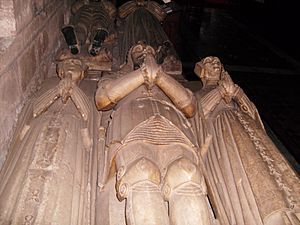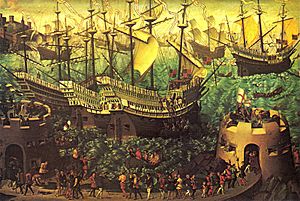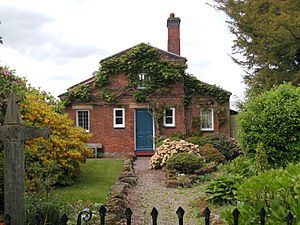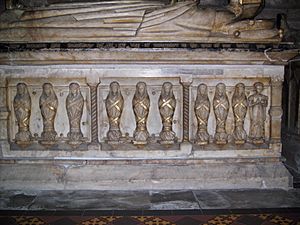John Giffard (died 1556) facts for kids
Sir John Giffard (born around 1465, died 1556) was a very important person in England during the time of King Henry VIII. He lived at Chillington in Brewood, Staffordshire. Sir John was a brave soldier, a trusted advisor to the king (called a courtier), a member of the English Parliament (like a modern-day politician), and a wealthy landowner.
Contents
Sir John's Early Life and Family
Sir John Giffard was the oldest son of Robert Giffard and Cassandra Humphreston. His family, the Giffards, had lived at Chillington since the late 1100s!
Not much is known about his early years. When he was about 17, in 1483, he married Jane Horde. Her father was a rich landowner from Bridgnorth. In 1486, when Sir John was around 20, his father passed away. Sir John then inherited all the family's lands, mostly around Brewood.
It's believed that his father-in-law, Thomas Horde, helped him get started at the royal court during the reign of King Henry VII. Sir John was well-known enough to attend King Henry VII's funeral in 1509. He was also at the coronation of the new king, Henry VIII. From that time on, he held important jobs in the royal household, like "gentleman usher." This meant he helped guide people and serve the king. He was also made a Justice of the Peace in Staffordshire in 1501, which meant he helped keep law and order. He held this important job for the rest of his life.
Serving the King: A Royal Courtier
Sir John Giffard's career really took off in 1509 when Henry VIII became king. Besides his roles as a gentleman usher, he was also made the Ranger of Cannock Forest. This meant he was in charge of looking after the king's forest. He kept this job until he died.
In 1513, he was knighted after a battle in France called the Battle of the Spurs. However, in 1515, Sir John upset the king. He remarried without asking the king's permission first! He had to pay a fine to make things right with Henry VIII.
Sir John spent over 30 years at court, often with the royal family at important events. In 1520, he traveled to France for the famous Field of the Cloth of Gold. This was a huge, fancy meeting between King Henry VIII and King Francis I of France. Two weeks later, he was also there when Henry VIII met Emperor Charles V.
Sir John was trusted by both King Henry VIII and his first wife, Queen Catherine. Even when the king and queen separated, Sir John's position remained strong. He was present at the coronation of Anne Boleyn in 1533, who became Henry VIII's second wife. Later, in 1539, he and his son, Thomas, helped prepare for the arrival of Anne of Cleves (Henry VIII's fourth wife) in England.
A Brave Soldier
Even though he spent a lot of time at court, Sir John Giffard was also a serious soldier. In 1513, he fought bravely in Henry VIII's invasion of northern France. English troops won the Battle of the Spurs and captured the important town of Tournai. During this campaign, Sir John was allowed to carry the Royal Standard of England (the king's flag) in front of the king. His friend, Edward Littleton, also fought alongside him. It was after capturing Tournai that Sir John was made a knight.
By 1533, he was made a "knight of the body." This was a special honor, meaning he was part of the king's personal bodyguard. In 1536, he was sent to help fight against the Pilgrimage of Grace. This was a large uprising in northern England against the king's changes to the church.
Serving in Parliament
Sir John Giffard was a Member of the English Parliament from 1529 to 1536. This period was known as the English Reformation Parliament, because many big changes to the church happened then.
He was elected as a "knight of the shire" for his home county of Staffordshire. This meant he represented the landowners of the county. He was considered one of the most important men in Staffordshire at the time.
Sir John was part of a group of Members of Parliament who met at the Queen's Head tavern to discuss things. Some people thought he might have disagreed with a law passed in 1533. This law, called the Statute in Restraint of Appeals, stopped people from appealing to the Pope in Rome. However, Sir John still attended Anne Boleyn's coronation, and there's no sign he opposed the king's later changes. In fact, he and his son were interested in buying lands from the monasteries after the king closed them down in 1536.
It's possible Sir John felt a little unsure about how fast things were changing. In 1533, he and his wife got permission to go on a pilgrimage to France. A pilgrimage is a special religious journey. They went to a shrine of John the Baptist, who was known for standing up to royal power. We don't know how long they stayed, but Sir John likely returned for more Parliament sessions. He certainly went north to fight for the king's decisions in 1536.
Sir John was over 70 years old by 1539, so his son Thomas took over his role in Parliament.
A Powerful Landowner
Sir John's main home was Chillington. It had a small village, a water mill, and a medieval moated manor house. Sir John completely rebuilt the house on the same spot. The new house was shaped like a square with a gatehouse. It was known for its interesting windows and chimneys. Today, only parts of Sir John's building remain, as a newer house was built there later.
There's a famous story that Sir John Giffard kept wild animals at Chillington. One day, a panther supposedly escaped! Sir John shot it with a crossbow. The spot where he shot it is now marked by "Giffard's Cross." The original wooden cross has been replaced with a replica.
Besides Chillington, Sir John also owned land in Walton and leased land from the Bishop of Lichfield in Hatton and Broom Hall. He even gave some land at Broom Hall to his son Thomas as a wedding gift. Sir John also gained several other important estates from the king, including Plardiwick, Pattingham, and Marston.
As a major landowner, Sir John Giffard was chosen as the High Sheriff of Staffordshire in 1509. This was a great honor. He was High Sheriff five more times throughout his life: in 1517–18, 1522–23, 1526–27, 1530–31, and 1541–42.
Family Life: Marriages and Children

Sir John Giffard was married twice.
- Jane Horde was his first wife. She was the daughter of Thomas Horde. They married in 1483. Jane died in 1491 while giving birth. She had seven daughters and two sons, including Thomas Giffard, who became Sir John's main heir. Most of their children seem to have died when they were very young.
- Elizabeth Montgomery was his second wife. She was the daughter of Sir Thomas Gresley. They married by April 1515, which is when Sir John got into trouble with King Henry VIII for not asking permission first. Elizabeth was a widow when she married Sir John. They had four sons and one daughter named Frances.
Sir John Giffard and his wives were buried in the church of St. Mary and St. Chad in Brewood. An amazing alabaster tomb was later placed there, with statues of all three of them.





